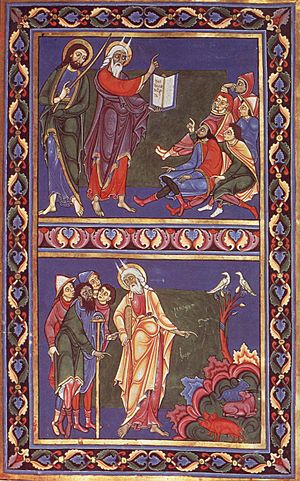Master Hugo facts for kids
Master Hugo was a very important artist from a long time ago, around the years 1130 to 1150. He was a Romanesque artist, which means his art style was popular in Europe during the Middle Ages. He was also the first professional artist we know of in England!
Contents
Who Was Master Hugo?
Master Hugo worked at Bury St Edmunds Abbey for many years. His career there is recorded from before 1136 to after 1148. He is most famous for creating amazing pictures in books, a process called "illuminating."
The Famous Bury Bible
Master Hugo is especially known for decorating the first part of the Bury Bible. This huge book was made for the Abbey around 1135. Today, you can find it in the Parker Library at Corpus Christi College in Cambridge.
His work on the Bury Bible was so special that many people consider him a brilliant artist. He helped shape the main style of English Romanesque art. We don't know if he also decorated the second part of the Bible. Only a small piece of that second part still exists today.
Other Amazing Creations
Master Hugo didn't just work on books. Records show he also made other impressive things for the Abbey:
- He created bronze doors for the main entrance of the Abbey church.
- He made a very large bell.
- He carved a crucifix with figures of Mary and Saint John. This carving was likely part of a "rood," which is a large cross placed in a church.
Some experts also believe Master Hugo might have made the famous ivory Cloisters Cross. This beautiful cross is now kept at The Cloisters museum in New York.
Where Did Master Hugo Learn His Skills?
We don't know exactly where Master Hugo was born or where he learned to be such a talented artist. However, his artwork gives us some clues.
The Fitzwilliam Museum suggests that his paintings show amazing colors and new styles. For example, the way he painted clothes and the deep, staring eyes of figures like Moses and Aaron are very unique. This makes people think he might have traveled a lot. He might have visited places like southern Italy, Cyprus, and even the Holy Land. These travels could have influenced his special artistic style.


